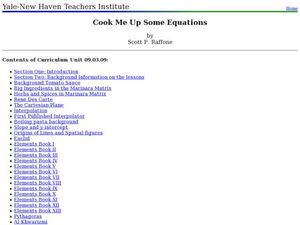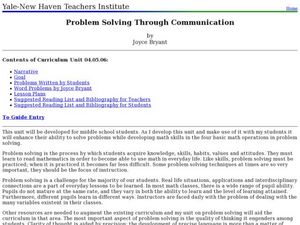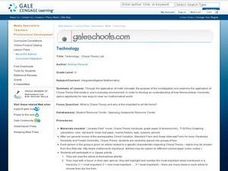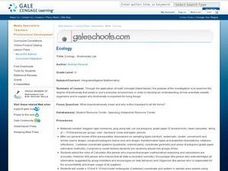Curated OER
Chance (Probability) Operations in Dance Composition -
Eighth graders investigate modern-dance choreographer Merce Cunningham's historically significant contribution to dance-making history. Specifically, 8th graders explore and practice Merce Cunningham's choreographic use of chance...
Curated OER
Ratios
Sixth graders use ratios to solve unit problems. Pupils write ratios in three different ways. In groups, they perform a bean activity, find ratios, and write them in simplest form.
Curated OER
Exploring the Slopes of Parallel and Perpendicular Lines
Students calculate the slope of parallel and perpendicular lines.In this algebra lesson plan, students differentiate between parallel and perpendicular lines. They graph their lines using the slope of the equation.
Curated OER
Exploring the Slopes of Parallel and Perpendicular Lines.
Pupils find the slopes for perpendicular and parallel lines. In this geometry lesson, students differentiate between parallel and perpendicular lines. They use Cabri software to create lines to compare.
Curated OER
The Slope of a Curve
Students graph the slopes of a line using the intercepts. In this precalculus lesson, students identify the properties of a curve slope. They find the limit and use a graping calculator to graph their lines.
Curated OER
Participating In The School Community
Twelfth graders discuss the importance of participating in the school community of their children. Working in pairs, partners describe the educational goals of children and how parents can support those goals. This lesson is intended...
Curated OER
Life with Energy
Students identify forms of energy and the advantages/disadvantages of different forms of energy. They describe ways in which technology affects the environment both good and bad. Finally, benefits are determines as well as the...
Curated OER
Analyze This
Students gain practice in the analysis of various types of graphs common in daily life. These examples often use graphic images like charts, graphs, tables, and pictures to supplement learning.
Curated OER
Percents: What's the Use
Students research percentages in real world situations. In this percents lesson, students demonstrate their ability to apply percents to everyday situations. Students communicate mathematically by conducting interviews about percents and...
Curated OER
Cook Me Up Some Equations
Young scholars study a variety of math concepts in the context of cooking up a meal. In this math lesson, students calculate surface area and volume. They draw and interpret different types of graphs.
Curated OER
What Are My Chances?
Students calculate probability. In this instructional activity on probability, students use given data to calculate to chances of a given event occurring. Many of the calculations in this instructional activity are applicable to daily life.
Curated OER
Pizza Party
Students explore the concept of fractions through use of hands on activity. For this lesson about fractions, students will work together in small groups with a round piece of paper, or pizza, and cut the pizza into pieces. Students will...
Curated OER
Mr. Bo Jangle, What's Your Angle?
Third graders explore angles. In this geometry lesson, 3rd graders identify and define acute, obtuse, and right angles. Students form angles with their bodies, find angles in picture books, and record angles found outside in their math...
Curated OER
Government Goods and Services
Fifth graders investigate the connection between taxes and government services. In this economics lesson plan, 5th graders discuss the process and benefits of paying sales and income taxes. Using calculators, students compute...
Curated OER
Relationship Between Addition and Subtraction
Students are taught how to add and subtract and use number sense to solve basic math problems. In this addition and subtraction instructional activity, students are being taught using theories from different philosophers in education....
Curated OER
Using Mathematics to Explain the Spread of Diseases
Students use statistics to solve problems based on the spread of disease. In this disease lesson plan students study the role that viruses and bacteria play in the spread of diseases and explain pandemics.
Curated OER
Reviewing Facts Through 10
Manipulatives are always fun for children to use. They use connecting cubes and blocks to solve addition and subtraction word problems with numbers up to 10. They then play a math game and use their cube to create number sentences....
Curated OER
How To Measure Time
Students practice telling time on an analog clock. In this time measurement lesson, students use individual analog clocks to identify the hour and minute hand. Students identify how to tell time by moving the hour and minute hand.
Curated OER
The Fourth Quadrant of Proportiona
Students experiment with scale to solve a problem presented in a video clip. They determine the correct size to use when constructing a model and evaluate the use of proportions in real life applications.
Curated OER
Problem Solving Through Communication
Students discuss effective ways to solve and communicate problems. In this word problem lesson, students solve a variety of word problems written by varying authors. They rewrite words using algebraic terminology.
Curated OER
Arrays And Factors
Students participate in a lesson plan that is concerned with the concepts of arrays and factors. They use a Hershey bar and divide it into segments in order to simulate the arrays. Then students construct other arrays from the leftover...
Curated OER
Introducing the Concept: Rates
Sixth graders explore rates as a specific type of ratio, using visual examples of unit rates and unit prices to increase comprehension. They also practice solving problems that are modeled by the instructor. The well-scripted...
Curated OER
Technology - Chaos Theory Lab
Ninth graders gain an understanding of Chaos Theory that exists in one's everyday environment.
Curated OER
Ecology - Biodiversity Lab
Studnents examine the degree of biodiversity that exists in one's everyday environment, in order to develop an understanding of how scientists classify organisms and to explain why biodiversity is important for living things.























